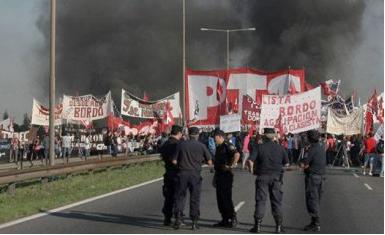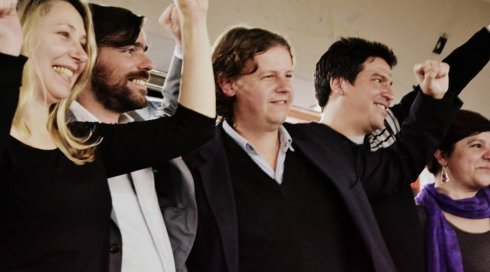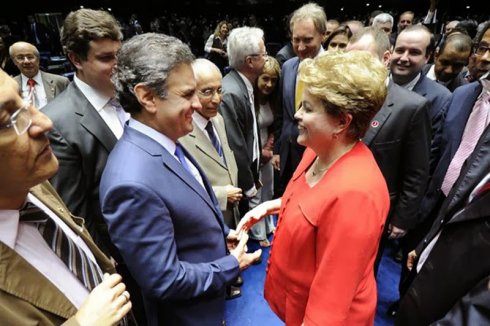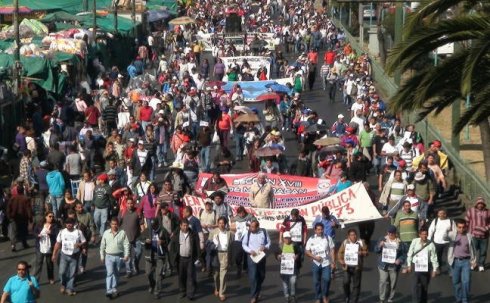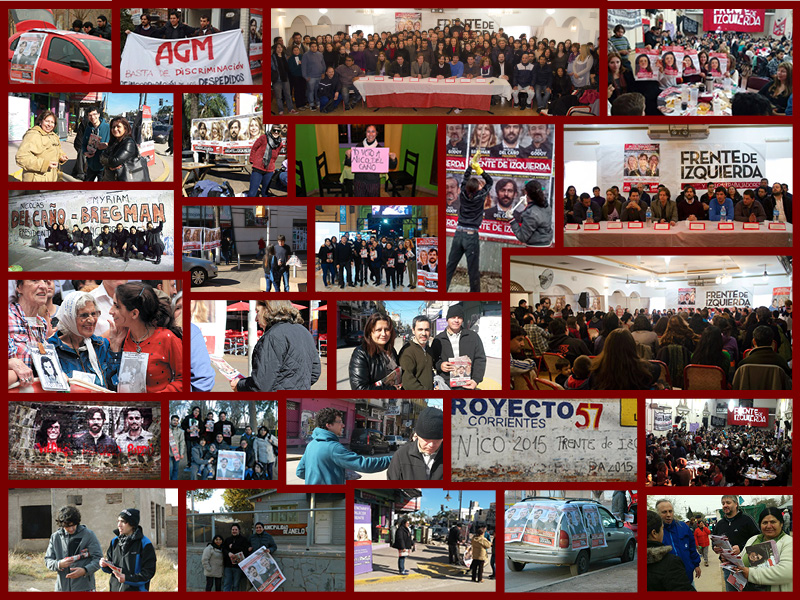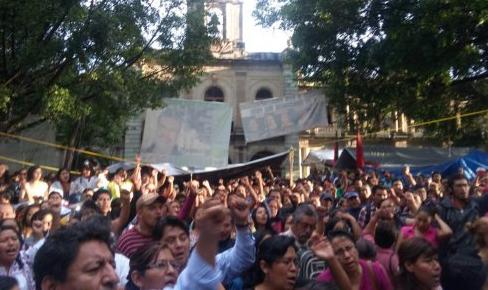A fundamental change in the international class struggle
The emergence of the new Chinese labor movement
16/06/2010
The wage increase of 30% at Foxconn, the Tawanese conglomerate and leading manufacturer in China shows a fundamental change in the new Chinese working class. This increase came after a wave of suicides of workers and especially the increase of 24% to 33% of the wages of workers at Honda, the Japanese automobile multinational with several plants in the country, after a strike lasting several days, and whose impact has spread to other auto parts plants and different regions such as Shanghai. These elements, which show the beginnings of a new labor movement in China, after its initial stage characterized by tens of thousands of incidents and short labor disputes, linked in turn to the emergence of a new generation of workers with higher aspirations than those of the first generation of migrant workers to the cities, still quite attached to their rural customs. This new stage of the struggle of Chinese workers has an impact worldwide, and together with the actions of the European working class, particularly the political general strike of May 5th of the Greek workers, shows that the working class, under the pressure of the crisis, is moving again on an international scale.
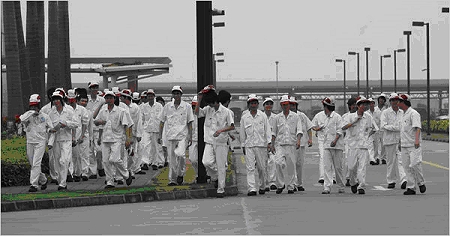
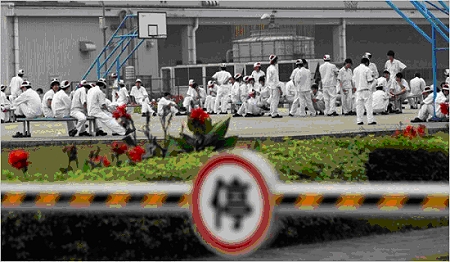
The first time the new Chinese labor movement
The Chinese working class is portrayed by Western analysts as meekly resignation to being subjected to exploitation. However, the commercialization of Chinese labor force was a disputed and problematic process since its inception. It implied a process of creation of a migrant workforce (a result first and foremost of the de-collectivization of agriculture in the late 1970s, which resulted in a significant amount of surplus labor), and at the same time the breaking of the "rice bowl and iron," the derogatory term used by the reformist supporters of the market to refer to the system of job security and social security benefits enjoyed by some of the urban working class linked to a particular work unit (danwei). In turn, the persistence of family registration system (hukou) [1] of the bureaucracy, which severely restricts the residence, education and health services in urban areas for the Chinese from rural areas, means that the stay of rural migrants in the cities is a transient and insecure experience. These workers receive only a temporary residence permit in exchange for a substantial fee, and some do not even have papers. This status as second-class citizens has in fact allowed for an internal immigrant population concentrated in the lowest levels of the working class.
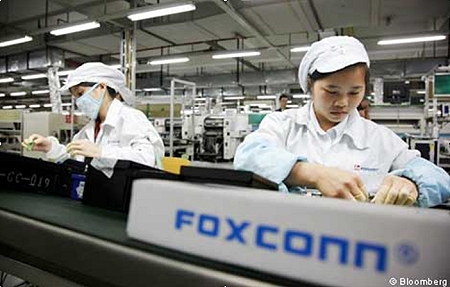
The responses of workers to the new conditions of exploitation and reproduction of their labor were swift, as evidenced by the revolutionary days of Tian’anmen Square, which together with the students, intellectuals, etc., began to organize a workers’ state sector independently, a process which was cut to peices by the restorationist bureaucracy, who particularly preyed on the labor leaders of the protest. This defeat allowed a period of acquiescence of employees in the first half of 1990, but compared to the accelerated integration of China into the capitalist world economy, especially its WTO entry in December 2001, the resistance of workers resumed, hitting a jump in size and amount during the current decade.
Until now the strongest responses had been found in the old labor movement of China. Between March and May 2002 in northeastern China, the center of state-owned heavy industry, three cities in the state of Dongbei (Liaoyang, Daqing and Fushun) hosted the largest demonstration since Tiananmen in 1989 [2]. But parallel to this process of resistance of the old Chinese proletariat and without having found unity with it for now, in recent years there have developed a plethora of protests from the new Chinese working class; "spontaneous incidents" as Chinese authorities vaguely refer to them. The claims are against overtime and illegal wage rates, non-payment of wages and other employer fraud against direct or indirect income workers and the non-payment of pension insurance. These are examples of migrant workers claiming their rights, at least those guaranteed by national labor laws and the Constitution, but they often do not apply at company level or district, due to the collusion of interests between managers and local dignitaries of the CCP. These legal requests, often in the absence of response or not, end up in street actions at the company. Until now there has not been a trend to a massive and inter-regional coordination of the two sectors of the Chinese working class, largely because capital accumulation is directed in a decentralized manner by the local authorities of the CCP.
A turning point: the emergence of the new China labor movement
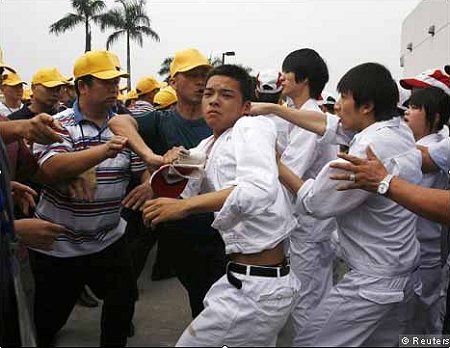
With regards to this first period of struggle of the new Chinese working class, the last workers’ actions marked a turning point. The wave of suicides in the manufacturing giant Foxconn Technology has challenged the system of exploitation of the workforce based on the maximization of exploitation through strenuous working hours, an oppressive military regime both inside and outside the workplace, and control over the reproduction of the labor force through giant labor-dormitaries in company-cities, where more than 300,000 workers live and work every day. Since these cases were exposed internationally, multinational subcontractor like Dell, Apple and Hewlett-Packard increased wages in China by 30%.
With regards to active measures by the workers, the strike by 1,900 employees of Honda Auto Parts Manufacturing of Foshan (Guangdong Province) finally got a salary increase of 24% to 33% for staff. This gear box factory was paralyzed for two weeks, producing a cessation of activities for four vehicle assembly plants owned by Japanese manufacturers operating in partnership with Chinese capital, in Guangzhou, Guangdond capital, and Wuhan (Hubei province, center), who all lost their supply of components. It is important to note that at least one third of the nearly 1,900 employees are workers trained in technical schools that joined the firm as temporary, an issue that has grown in recent times under the pressure of the economic recovery. This success has led to a spread of struggle to other auto parts companies linked to a joint venture of the same Japanese firm, with a strike and rapid achievement of a wage increase in a Hyundai automobile plant, and more significantly to the spreading of this process beyond the heart of China’s industrial south, which poses a dangerous new challenge for Beijing. For example workers from KOK Machinery in Kunshan, a Taiwanese machinery factory on the outskirts of Shanghai, on Tuesday 8 / 6 clashed with police, leaving about 50 protesters injured. The confrontation represented an escalation of the recent actions of labor protest in the country, which until this week had been largely peaceful and were concentrated in the southern province of Guangdong.
These actions, unlike the previous period, have an offensive nature, are sporadic and are held for a longer period of time, affecting major multinationals such as Honda for the first time, and for now these struggles have escaped the control of the All-China Federation of Trade Unions, the sole and "official" union of the country. An example is the case of Honda workers that tried to organize themselves independently and clashed with thugs in the pay of the bureaucracy who tried to force them to return to work [3]. Everything suggests that a new state of mind of the Chinese workers could be developing faster than expected, leaving the authorities and the official trade union organization disorientated. As this reporter from the Financial Times says: "Unrest in Foshan suggest that strikes are multiplying faster than the capacity of local governments and the All-China Federation of Trade Unions - which workers have largely by-passed in recent protests - to resolve them. While there is no evidence that workers in different factories are coordinating their activities, the success of Honda’s first strike has emboldened workers, demonstrating that mass action can yield results [4].
A new generation of workers
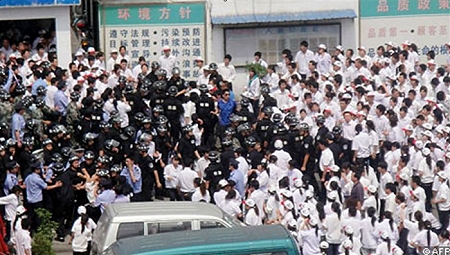
There are structural factors that have influenced the turning point of the struggle of Chinese workers mentioned above; demographic changes, including years of the "one child" population control policy of the government and the consequent fall in the number of young and middle-aged people who enter the labor market (especially in relation to the growing demand.) Economic factors have also had an effect, such as the recent stimulus plan that encouraged job creation near the villages, which led to fewer rural workers moving to the cities, and growing inflation.
However, the main explanation lies elsewhere. These unexpected workers’ actions, and the wave of suicides in Foxconn, are expressions of the appearance on the scene of a second generation of Chinese workers with fewer roots in the countryside; who want to settle in cities; who are more educated and less prepared to bear (resentfully) the harsh working conditions of the previous generation, more aware of their rights, yet with greater expectations for the future than the first generation of workers who were still very tied to the countryside [5] and was prepared to make sacrifices to improve the situation of their families. This new generation wants to progress, but the price of the housing in which it aspires to live has shot through the roof in the middle of a real estate boom and is increasingly unattainable, while the price of consumer goods, especially food, is increasing due to inflation. The testimonies of the press are telling. Take just one, from Longhua, a city north of Shenzhen, in southern China, where the main factory-city of Foxconn is located, (created by Terry Gou, the boss of Taiwanese origin in 1988): "There has been at least a huge change within the workforce. ’The monotonous work I do here has nothing in common with my idea of life, it makes no sense, "says Lu Pengguo, a logistics worker 22 years of age in Longhua of the inland province of Henan. "My father tells me keep the job. But as soon as I find something better, I will." The new generation of workers is very different from that which helped Mr. Gou to build manufacturing machines. Twenty years ago the workers saw a job in the factory as the opportunity of a lifetime and for many the food and accommodation offered at the plant would not have been worse than you would expect at home. Now, 90 percent of Foxconn workers are between 18 to 24 years old. Born after China started its economic reforms, most have much higher expectations. ’Migrant workers today want other things in life, want to have fun, "says Mr. Liu. Foxconn has tried to adapt by building sports facilities, libraries and Internet cafes on campus. With banks, post offices, shops and chain restaurants, the streets of the complex appear no different to those on the outside. But while Foxconn is clearly not a sweat shop, there is little time and energy for recreation” [6].
As we see there is a challenge not only to the wage conditions - almost one worker in four in China did not see their wages increase in five years [7] - but also to the conditions of reproduction of the labor force and, most acutely of all, to the alienating work process itself [8]. The return to a factory like that brilliantly depicted by Charles Chaplin in Modern Times is a reality in today’s China on an unmatched and unparalleled scale [9], but may to be coming to an end with the rebellion of the second generation of Chinese workers.
A bankrupt model of management of the labor force and the dangerous course of China’s transition to a new economic model
Recent industrial developments in China are showing the first structural gaps of a model of control and management of the labor force which became extremely effective at maximizing the exploitation of workers, and for the large conglomerates such as Foxconn and Yue Yuen Industrial (a giant Taiwanese industrial property that produces 17% of the shoes in the world especially for Nike and Adidas) that take advantage of economies of scale to lower costs, the reaping of succulent profits. At the same time this puts pressure on a relationship of suppliers and customers which was built up over the years, allowing a global division of labor where giant companies and brands such as Apple, Nike (to take the most symbolic examples in their sectors) are engaged in design, innovation and marketing, while detaching themselves from all contact with the production, which is undertaken by large specialist firms with Taiwanese bosses educated in the Japanese-style militarization of labor, and building on their good connections in Mainland China and its vast reserve army of labour; a model which prospered to unimaginable levels. The emergence of a new generation of Chinese workers is changing these coordinates that some Western economists and managers believed would be sustainable indefinitely.
We are facing a dangerous time for the Beijing authorities who have still not woken up to the new reality of the world of work. As Andy Xie says: "Recent developments in Foxconn and Honda plants are symbols of this new China. The workforce is not as abundant or obedient as before, and the ways in which governments and companies are handling the situations exposes their ignorance of the new reality. They still believe these are isolated incidents, and that through pressure and bribery (for example, a salary increase for all and then the dismissal of the rebel leaders) they can bring the situation back to normal. They think this way because of a generation gap, and the unusual relationship between local governments and enterprises in China. The economy has run three times faster than Western economies did a century ago, and the generation gap appears three times bigger too. Today’s young adults and their parents can be from different centuries. But leaders of government and business are all from the parental generation, handling this crisis from the old labor perspective. The ruling class judges everything in the short run, based on marginal economic improvement and not based on dreams and long-term goals. Young people today are more concerned about what will happen in the future. They want to settle in large cities and have interesting and well paid jobs - just like their counterparts in other countries. This huge generation gap in perception is the driving force behind social tension in China’s housing bubble and working conditions in factories" [10].
Although the generation gap is a factor, it is essential that this lack of adaptation to the reality of the restorationist bureaucracy is not just collusion with business interests but their contempt for the masses who they treat as an ignorant mass, as can be seen in their arrogance in the local Petitions Buros day after day, attended by hundreds of workers with labor grievances or otherwise, reflected so well by the young Chinese filmmaker Zhao Liang, in his brilliant film "Petition, la Cour des plaignants" which portrays the struggle of hundreds of people who come to Beijing seeking a response to their claims, dismissed by local and regional bureaucracies for years, only to receive the same fate in the capital.
Against this backdrop of a widening gap between Chinese workers and their leaders, employers like Terry Gou, Foxconn owner, have changed the rules in labor-management relations. At the annual meeting of its sister group in Taipei, the capital of Taiwan, announced not only an increase of 30% already mentioned but a more radical modification of the old system of work, beginning with a 66% increase from 1 October workers who meet certain performance conditions over a period of three months assessment, which seeks to prevent workers changing jobs, saying it wants to keep paying the cost of the suicides and that this is what the Chinese Government has to take care of social benefits and housing for the workers (now borne by the company). Guo said that developments in his company and Honda "made him realize that the [structure of manufacturing in China] has to change" [11]. This appears to be a strategic move by this highly important capitalist, a member of Fortune 500 ranking of the richest people in the world, to put pressure on his competitors, forcing them to follow, while some of the burden passes onto his customers, while at the same time throwing the heavy burden of reproduction of the conditions of the workforce to the state [12]. The “collateral damage” of this socialization of the costs of reproduction of the work force would be that it could politicize the struggle so that it took place against not only the employers but also the state, overcoming the close links which have so far existed between workers struggles and the individual units of production.
From the economic point of view and in the context of the continuing crisis of global overproduction and a demand that is contracting in the context of the crisis in the eurozone and the end of the American model based on consumption and debt, the change of model like that at Foxconn can sink many companies who cannot absorb increases in labor costs, which although marginal for many major manufacturers, may not be for many other smaller companies with lower productivity that will see themselves doomed to bankrupcy. Likewise the global economic crisis has bankrupted hundreds of companies in southern China, where the social cost was only mitigated by the role the village still plays as a cushion, helping with the reproduction of the social labor force in addition to the phenomenal farewell state spending plan released by the Chinese government in the middle of the most acute crisis. But while this move is inevitable, the government and the Chinese authorities are worried about the transition, trying to manage the process as gradually and carefully as possible. However, Beijing’s intentions might collide with the strong interest of the authorities of the coast that would come out clearly as losers in this process. Moreover and most importantly, the acceleration of the awakening of this second generation of Chinese workers could disrupt the plans of the central bureaucracy and to derail the transition to a new model more balanced if the awakening worker acquires an autonomous and goes beyond what you want restorationist bureaucracy. If this is the case for the new weight of China in the global economy, the consequences would be felt globally, an issue that the world is concerned, so the alarm in all the papers at the recent imperialist movements Chinese workers. A new battalion of the world working class, one of the strongest and structural power, begins to enter the scene. Stay tuned.
NOTASADICIONALES
[1] The original purpose of the hukou, established in 1955 under Mao, was the rationing of goods in an economy of scarcity, especially preventing a mass of peasants flooding the cities to seek employment in state enterprises, in which employment was restricted to legal urban residents.
[2] The key case was Liaoyang Ferroalloy Factory and unlike many incidents of retired workers, working-class neighborhoods in decline, etc., all sectors managed to unite in a fight against the end of all the companies legal obligations towards its workers and retired workers once it went bankrupt. This last fact was what led to the widespread protests that until then had been fragmented, even within each factory, due to the various achievements and commitments of the various sectors of workers. It was a protest against the central status that workers had in the old China of Mao. It was an action of the old proletariat, driven centrally by the anger at corruption among managers who had bankrupted many of these companies for their benefit. At the head of the struggle was the middle generation (neither retirees who are entitled to the state benefits, such as compensation for services performed for the revolution, nor the superexploited young workers on the coast), so it is called the "lost generation" and is the most angry sector within the state industrial workforce.
[3] The Economist finds that in the Honda plant, workers hate the union more than the Japanese managers: "Young Chinese often take advantage of any opportunity to punish the Japanese, whom they consider insufficiently appalled by the atrocities of the Second World War. But at the Honda plant, employees are more angry with the union than the Japanese factory managers. On May 31, more than one hundred senior members of the union were sent to the factory by the local government. Some clashed with workers trying to reach the door to speak with reporters. ’They are the Mafia’, complained an employee, another was a long cut on his face that he blamed the union members.
Several workers complained that despite paying the membership fees of around 10 yuan ($ 1.50) per month, they had received virtually nothing from the union, much less help to negotiate with management. " "Unions in China: Strike breakers," The Economist 3/6/2010
[4] “Chinese labour unrest spreads”, Financial Times 9/6/2010
[5] "The alienated Chinese workers have signalled their determination to fight. ’We are different from our parents’ generation," said Cha Jinhua, a union activist based in Guangdong. ’Their wishes were simple - win some money and return to their places of origin. We want to stay in the cities and enjoy our lives here. But we demand respect ’. " "Chinese workers swap angst for anger ", Financial Times 31/5/2010
[6] “Suicides put Foxconn under scrutiny”, Financial Times 23/5/2010
[7] The difference between a Chinese and a foreign employee is also frustrating: according to the press, local staff at Honda complained that they are paid 50 times less than the Japanese who work in the same factory.
[8] Another example of the latter: "These, for instance, are the thoughts of Pengguo Lu, a logistics worker: ’At work, there is pressure all the time. Sometimes, everything feels so helpless. So sometimes I feel really tired, upset, I do not want to work here anymore. . . . In our production we do the same every day, again and again, day after day, month after month, year after year. It makes me feel exhausted. ’"" A new generation of Chinese tires of drudgery, "John Gapper Business Blog in the Financial Times 05/24/2010
[9] This unfortunately is not a metaphor: "The reporter from Southern Weekly has found the staff dulled by the monotony of repetitive tasks, including walking and feeding the rhythm of the rumbling of the machines," "The Dark Side of China’s enduring dream" David Pilling Financial Times 05/26/2010
[10] Dismantling Factories in a Dreamweaver Nation”, Andy Xie Caixin 7/6/2010
[11] “Foxconn to scrap ‘factory town’ model”, Financial Times 8/6/2010
[12] "Mr.Gou said that companies like Foxconn - who operate a wide range of social services for staff in their huge factory-cities - had to build a community from scratch around their plants when they entered China during the early days of liberalization and economic development. But "today we will return to these social functions to the government ’." Idem.
